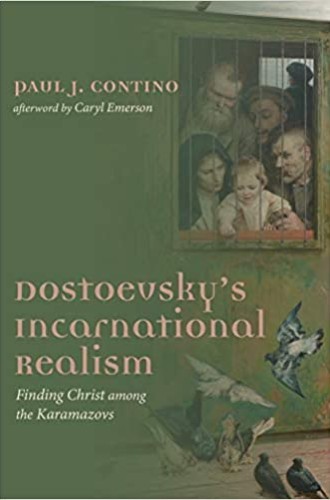On the path to holiness with Dostoevsky
Paul Contino offers a hope-filled reading of The Brothers Karamazov.
“What is the last book you read that you remember reading and enjoying?” I ask students on the first day of the introductory literature course I teach at a vocationally focused college. The class is a general education requirement, and few of my students read for pleasure. If I’m lucky, some might respond with a recent favorite; others need to search their memories as far back as Dr. Seuss. I then pose another question: “Do you believe that stories can make us better people?”
For educators in the ancient and medieval worlds, the response to this question was a resounding yes. Later on, perhaps alongside a decline in the authority of religion, the answer became “not necessarily.” Ever since 2017, when the #MeToo movement exposed the prevalence of sexual abuse among influential people—including writers—the answer for many remains no. Nevertheless, recent scientific studies have suggested that reading novels can indeed increase our compassion and generosity.
Read our latest issue or browse back issues.
For Paul Contino, reading literature is an integral part of a spiritual path toward greater wholeness and, if coupled with humility, holiness. Drawing on the theology of his own Catholic faith as well as ecumenical Christian perspectives, he offers a hope-filled reading of Fyodor Dostoevsky’s 1879 classic, The Brothers Karamazov.
With its detailed analyses of plot points and character development, Contino’s book presumes knowledge of the primary text. But if reading Dostoevsky is an intellectual milestone you’ve not yet reached, Contino might serve as a helpful guide. And if Dostoevsky’s long-cherished novel is one you remember loving in youth but haven’t dusted off in decades, Contino’s critical analysis just might inspire you to pick it up again.
A commonly noted flaw of much literary criticism is opaqueness and inaccessibility; so often it is written by scholars for scholars. Thankfully, Contino’s analysis does not suffer from this weakness. Written with lucidity and great beauty, this study is suitable for a popular audience. What makes it especially relevant for Christian readers is the theological focus on Dostoevsky’s “incarnational realism,” which Contino defines as the “philosophical/theological belief that the human mind is capable of apprehending the world as it is ontologically, even with our epistemological limitations and inheritance of ‘social constructions.’” To achieve this knowledge of reality, we need to cultivate virtues such as humility and prudence. “Rather than egocentrically projecting a predetermined schema upon reality,” such a virtue “remains receptively open to reality.”
The main character who embodies this incarnational realism is Father Zosima, the spiritual mentor to the youngest Karamazov brother, Alyosha. It is he who makes the statement that Catholic Worker cofounder Dorothy Day found so resonant: “Love in practice is a harsh and dreadful thing compared to love in dreams.” The Christian ideal of active love—practiced slowly and consistently over long periods of time, without the validation of any real or imagined audience—is the defining characteristic of the wise elder. However, Contino carefully notes that Zosima must take a long journey before attaining the wisdom needed to mentor others. In his youth, he “willfully constructs a drama of projected love, insult, and potential violence.” Growing in holiness does not entail being without flaw.
Contino also explores the character development of the three Karamazov brothers. Most of the emphasis is placed upon Alyosha, who does indeed go on to embody Christlike active love. However, even more compelling are his analyses of Alyosha’s two older brothers. The middle child, Ivan, remains trapped by pride and nadryv, or the bitterness that comes when we feel ourselves ripped apart by internal conflict. The firstborn, Dmitri, manages to overcome pride and find redemption through humility. Again and again, Contino notes, a major stumbling block for Dostoevsky’s characters is excessive preoccupation with the opinions of others. On the one hand, “as social creatures, we will always be seen by others.” On the other, “the demonic is yoked to the fear of being seen as ‘ridiculous.’”
All works of criticism are essentially limited in scope; it is never possible to discuss everything. Contino merely grazes the surface of some issues that I would like to see fleshed out more fully. One is the particularities of Orthodox theology. While incarnational realism is important for all branches of Christianity, Contino readily admits that his reading is heavily informed by his own tradition of Roman Catholicism—a tradition which, as he notes, Dostoevsky held in little esteem. While I greatly appreciate Contino’s focus on the Catholic imagination, especially the moments where he compares Alyosha’s spiritual journey to that of Dante in the Divine Comedy, I would like a little more exploration of the specifically Orthodox implications of Dostoevsky’s work.
One ongoing critique that Dostoevsky has faced is his propensity toward antisemitism, which in 19th-century Russia was the social water he swam in. Contino does well to acknowledge and name this problem, but in my view he does so too briefly and apologetically. He speculates that Dostoevsky’s faith “would have given him the courage to renounce his sins of anti-Semitism and chauvinistic nationalism” had he lived at a later time. Given the resurgence of both of these tendencies across the world in recent years, I am not so confident about this. I believe that Contino could have dedicated a little more space in the book to exploring the complexities of Dostoevsky’s antisemitism.
A final aspect of this book that disappointed me is that nowhere does Contino mention the fact that his reading is of a book in translation. As an Anglophone reader who has never studied Russian, I am only able to access Dostoevsky’s masterpiece due to the thoughtful artistry of literary translators. Lawrence Venuti and others have critiqued readers’ tendencies to render translation and translators invisible. Discussing the importance of translation—and perhaps devoting even a few pages to comparing the strengths and weaknesses of different English versions of this classic text—would add a necessary piece to Contino’s study that is currently missing.
Still, this study is a delight to read and a reminder that literary criticism is an art that can breathe new life into old texts and turn them into a lens through which to contemplate the challenges of our own times. In our crisis-ridden age, Contino locates a response in Dostoevsky’s vision: “Christ-like active love, rooted in God’s grace.” Contino reminds us that we are all called to respond with love in this fallen world.






